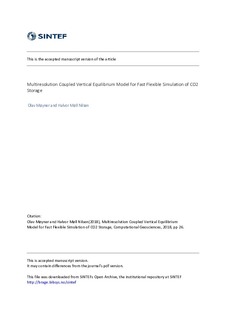| dc.contributor.author | Møyner, Olav | |
| dc.contributor.author | Nilsen, Halvor Møll | |
| dc.date.accessioned | 2018-10-17T05:36:41Z | |
| dc.date.available | 2018-10-17T05:36:41Z | |
| dc.date.created | 2017-11-21T10:38:59Z | |
| dc.date.issued | 2018 | |
| dc.identifier.citation | Computational Geosciences. 2018, pp 20 | nb_NO |
| dc.identifier.issn | 1420-0597 | |
| dc.identifier.uri | http://hdl.handle.net/11250/2568339 | |
| dc.description.abstract | CO2 capture and storage is an important technology for mitigating climate change. Design of efficient strategies for safe, long-term storage requires the capability to efficiently simulate processes taking place on very different temporal and spatial scales. The physical laws describing CO2 storage are the same as for hydrocarbon recovery, but the characteristic spatial and temporal scales are quite different. Petroleum reservoirs seldom extend more than tens of kilometers and have operational horizons spanning decades. Injected CO2 needs to be safely contained for hundreds or thousands of years, during which it can migrate hundreds or thousands of kilometers. Because of the vast scales involved, conventional 3D reservoir simulation quickly becomes computationally unfeasible. Large density difference between injected CO2 and resident brine means that vertical segregation will take place relatively quickly, and depth-integrated models assuming vertical equilibrium (VE) often represents a better strategy to simulate long-term migration of CO2 in large-scale aquifer systems. VE models have primarily been formulated for relatively simple rock formations and have not been coupled to 3D simulation in a uniform way. In particular, known VE simulations have not been applied to models of realistic geology in which many flow compartments may exist in-between impermeable layers. In this paper, we generalize the concept of VE models, formulated in terms of well-proven reservoir simulation technology, to complex aquifer systems with multiple layers and regions. We also introduce novel formulations for multi-layered VE models by use of both direct spill and diffuse leakage between individual layers. This new layered 3D model is then coupled to a state-of-the-art, 3D black-oil type model. | nb_NO |
| dc.language.iso | eng | nb_NO |
| dc.title | Multiresolution Coupled Vertical Equilibrium Model for Fast Flexible Simulation of CO2 Storage. | nb_NO |
| dc.type | Journal article | nb_NO |
| dc.type | Peer reviewed | nb_NO |
| dc.description.version | acceptedVersion | nb_NO |
| dc.source.pagenumber | 26 | nb_NO |
| dc.source.journal | Computational Geosciences | nb_NO |
| dc.identifier.cristin | 1516510 | |
| dc.relation.project | Norges forskningsråd: 243729 | nb_NO |
| dc.relation.project | Norges forskningsråd: 257579 | nb_NO |
| cristin.unitcode | 7401,90,11,0 | |
| cristin.unitname | Anvendt matematikk | |
| cristin.ispublished | true | |
| cristin.fulltext | postprint | |
| cristin.qualitycode | 1 | |
